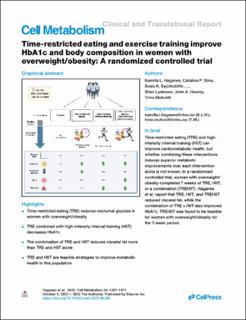Time-restricted eating and exercise training improve HbA1c and body composition in women with overweight/obesity: A randomized controlled trial
| dc.contributor.author | La Haganes, Kamilla | |
| dc.contributor.author | Silva Ruiz, Catalina Paz | |
| dc.contributor.author | Eyjolfsdottir, Svala Kristfridur | |
| dc.contributor.author | Steen, Sandra | |
| dc.contributor.author | Grindberg, Martine | |
| dc.contributor.author | Lydersen, Stian | |
| dc.contributor.author | Hawley, John A | |
| dc.contributor.author | Moholdt, Trine Tegdan | |
| dc.date.accessioned | 2023-04-12T11:37:35Z | |
| dc.date.available | 2023-04-12T11:37:35Z | |
| dc.date.created | 2023-01-04T13:45:14Z | |
| dc.date.issued | 2022 | |
| dc.identifier.citation | Cell Metabolism. 2022, 34 (10), 1457-1471. | en_US |
| dc.identifier.issn | 1550-4131 | |
| dc.identifier.uri | https://hdl.handle.net/11250/3062649 | |
| dc.description.abstract | Summary Diet modification and exercise training are primary lifestyle strategies for obesity management, but poor adherence rates limit their effectiveness. Time-restricted eating (TRE) and high-intensity interval training (HIIT) improve cardiometabolic health in at-risk individuals, but whether these two interventions combined induce superior improvements in glycemic control than each individual intervention is not known. In this four-armed randomized controlled trial (ClinicalTrials.gov NCT04019860), we determined the isolated and combined effects of 7 weeks of TRE (≤10-h daily eating window, with ad libitum energy intake) and HIIT (three exercise sessions per week), compared with a non-intervention control group, on glycemic control and secondary cardiometabolic outcomes in 131 women (36.2 ± 6.2 years) with overweight/obesity. There were no statistically significant effects after isolated TRE, HIIT, or a combination (TREHIIT) on glucose area under the curve during an oral glucose tolerance test (the primary outcome) compared with the control group (TRE, −26.3 mmol/L; 95% confidence interval [CI], −82.3 to 29.7, p = 0.36; HIIT, −53.8 mmol/L; 95% CI, −109.2 to 1.6, p = 0.057; TREHIIT, −41.3 mmol/L; 95% CI, −96.4 to 13.8, p = 0.14). However, TREHIIT improved HbA1c and induced superior reductions in total and visceral fat mass compared with TRE and HIIT alone. High participant adherence rates suggest that TRE, HIIT, and a combination thereof may be realistic diet-exercise strategies for improving markers of metabolic health in women at risk of cardiometabolic disease. | en_US |
| dc.language.iso | eng | en_US |
| dc.publisher | Elsevier | en_US |
| dc.rights | Attribution-NonCommercial-NoDerivatives 4.0 Internasjonal | * |
| dc.rights.uri | http://creativecommons.org/licenses/by-nc-nd/4.0/deed.no | * |
| dc.title | Time-restricted eating and exercise training improve HbA1c and body composition in women with overweight/obesity: A randomized controlled trial | en_US |
| dc.title.alternative | Time-restricted eating and exercise training improve HbA1c and body composition in women with overweight/obesity: A randomized controlled trial | en_US |
| dc.type | Peer reviewed | en_US |
| dc.type | Journal article | en_US |
| dc.description.version | publishedVersion | en_US |
| dc.source.pagenumber | 1457-1471 | en_US |
| dc.source.volume | 34 | en_US |
| dc.source.journal | Cell Metabolism | en_US |
| dc.source.issue | 10 | en_US |
| dc.identifier.doi | 10.1016/j.cmet.2022.09.003 | |
| dc.identifier.cristin | 2100557 | |
| cristin.ispublished | true | |
| cristin.fulltext | original | |
| cristin.fulltext | original | |
| cristin.qualitycode | 2 |

